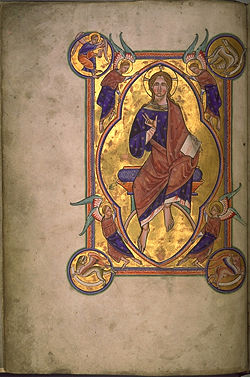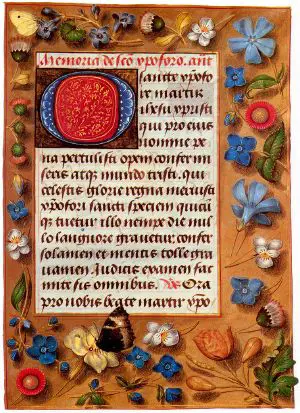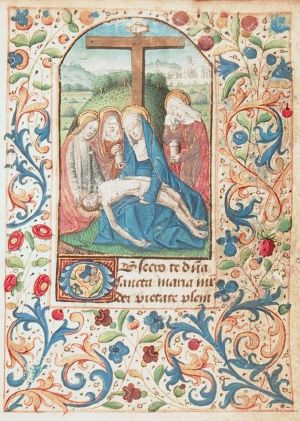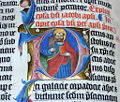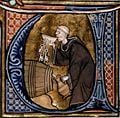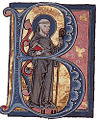Illuminated manuscript
An illuminated manuscript is a manuscript in which the text is supplemented by the addition of decoration, such as decorated initials, borders and miniature illustrations. In the strictest definition of the term, an illuminated manuscript only refers to manuscripts decorated with gold or silver. However, in both common usage and modern scholarship, the term is now used to refer to any decorated or illustrated manuscript from the Western or Islamic traditions; comparable Far Eastern works are always described as painted, as often are Islamic and Mesoamerican works.
Many illuminated manuscripts were made by monks at monasteries. As with other religious works, the creative process involved in making an illuminated manuscript was also a time of religious devotion and prayer; monks used bright colors in order to illustrate the religious truth and the glory of God.
History
The earliest surviving substantive illuminated manuscripts are from the period 400 to 600 C.E. (also in the gothic period), primarily produced in Ireland, Constantinople and Italy. The significance of these works lies not only in their inherent art history value, but in the maintenance of a link of literacy offered by non-illuminated texts as well. Had it not been for the monastic scribes of Late Antiquity, the entire literature of Greece and Rome would have perished; as it was, the patterns of textual survivals were shaped by their usefulness to the severely constricted literate group of Christians. The very existence of illuminated manuscripts as a way of giving stature and commemoration to ancient documents may have been largely responsible for their preservation in an era when barbarian hordes had overrun continental Europe and ruling classes were no longer literate.
The majority of surviving manuscripts are from the Middle Ages, although many illuminated manuscripts survive from the fifteenth century Renaissance, along with a very limited number from Late Antiquity. The majority of these manuscripts are of a religious nature. However, especially from the thirteenth century onward, an increasing number of secular texts were illuminated. Most illuminated manuscripts were created as codices, which had superseded scrolls; some isolated single sheets survive. A very few illuminated manuscript fragments survive on papyrus. Most medieval manuscripts, illuminated or not, were written on parchment (most commonly of calf, sheep, or goat skin), but most manuscripts important enough to illuminate were written on the best quality of parchment, called vellum, traditionally made of unsplit calf skin, though high quality parchment from other skins were also called parchment.
Beginning in the late Middle Ages manuscripts began to be produced on paper.[1] Very early printed books were sometimes produced with spaces left for rubrics and miniatures, or were given illuminated initials, or decorations in the margin, but the introduction of printing rapidly led to the decline of illumination. Illuminated manuscripts continued to be produced in the early sixteenth century, but in much smaller numbers, mostly for the very wealthy.
Illuminated manuscripts are the best surviving specimens of medieval painting, and the best preserved. Indeed, for many areas and time periods, they are the only surviving examples of painting.
Techniques

Illumination was a complex and frequently costly process. It was usually reserved for special books: an altar Bible, for example. Wealthy people often had richly illuminated "books of hours" made, which set down prayers appropriate for various times in the liturgical day.
In the early Middle Ages, most books were produced in monasteries, whether for their own use, for presentation, or for a commission. However, commercial scriptoria grew up in large cities, especially Paris, and in Italy and the Netherlands, and by the late fourteenth century there was a significant industry producing manuscripts, including agents who would take long-distance commissions, with details of the heraldry of the buyer and the saints of personal interest to him (for the calendar of a Book of hours). By the end of the period, many of the painters were women, perhaps especially in Paris.
Text
In the making of an illuminated manuscript, the text was usually written first. Sheets of parchment or vellum, animal hides specially prepared for writing, were cut down to the appropriate size. After the general layout of the page was planned (e.g., initial capital, borders), the page was lightly ruled with a pointed stick, and the scribe went to work with ink-pot and either sharpened quill feather or reed pen.
The script depended on local customs and tastes. The sturdy Roman letters of the early Middle Ages gradually gave way to scripts such as Uncial and half-Uncial, especially in the British Isles, where distinctive scripts such as insular majuscule and insular minuscule developed. Stocky, richly textured blackletter was first seen around the thirteenth century and was particularly popular in the later Middle Ages. Palaeography is the study of historical handwritten scripts, and codicology the related study of other physical aspects of manuscript codexes.
Classifications
Art historians classify illuminated manuscripts into their historic periods and types, including (but not limited to): Late Antique, Insular, Carolingian manuscripts, Ottonian manuscripts, Romanesque manuscripts, Gothic manuscripts, and Renaissance manuscripts. There are a few examples from later periods. The type of book that was most often heavily and richly illuminated, sometimes known as a "display-book," varied between periods. In the first millennium these were most likely to be Gospel Books. The Romanesque period saw the creation of many huge illuminated complete Bibles—one in Sweden requires three librarians to lift it. Many Psalters were also heavily illuminated in both this and the Gothic period. Finally, the Book of Hours, very commonly the personal devotional book of a wealthy layperson, was often richly illuminated in the Gothic period. Other books, both liturgical and not, continued to be illuminated at all periods. The Byzantine world also continued to produce manuscripts in its own style, versions of which spread to other Orthodox and Eastern Christian areas (see Medieval art for other regions, periods and types).
The Gothic period, which generally saw an increase in production, also saw more secular works such as chronicles and works of literature illuminated. Wealthy people began to build up personal libraries; Philip the Bold, Duke of Burgundy, who probably had the largest personal library of his time in the mid-fifteenth century, is estimated to have had about 600 illuminated manuscripts, whilst a number of his friends and relations had several dozen.
Images
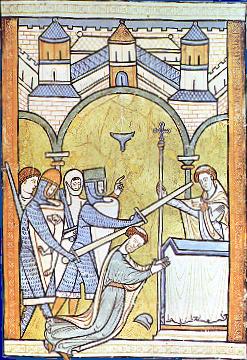
When the text was complete, the illustrator set to work. Complex designs were planned out beforehand, probably on wax tablets, the sketch pad of the era. The design was then traced or drawn onto the vellum (possibly with the aid of pinpricks or other markings, as in the case of the Lindisfarne Gospels). Many incomplete manuscripts survive from most periods, giving us a good idea of working methods.
At all times, most manuscripts did not have images in them. In the early Middle Ages, manuscripts tend to either be display books with very full illumination, or manuscripts for study with at most a few decorated initials. By the Romanesque period many more manuscripts had decorated or historiated initials, and manuscripts essentially for study often contained some images, often not in color. This trend intensified in the Gothic period, when most manuscripts had at least decorative flourishes in places and a much larger proportion had images of some sort. Display books of the Gothic period in particular had very elaborate decorated borders of foliate patterns, often with small drolleries. A Gothic page might contain several areas and types of decoration: a miniature in a frame, a historiated initial beginning a passage of text, and a border with drolleries. Often different artists worked on the different parts of the decoration.
Paints
The medieval artist's palette was surprisingly broad:
| Colour | Source(s) |
|---|---|
| Red | Mercury(II) sulfide (HgS), often called cinnabar or vermilion, in its natural mineral form or synthesized; "red lead" or minium (Pb3O4); insect-based colors such as cochineal, kermes and lac; rust (iron oxide, Fe2O3) or iron oxide-rich earth compounds |
| Yellow | Plant-based colors, such as Weld, turmeric or saffron; yellow earth colors (ochre); orpiment (arsenic sulfide, As2S3) |
| Green | Plant-based compounds such as buckthorn berries; copper compounds such as verdigris and malachite |
| Blue | Ultramarine (made from the rock lapis lazuli); azurite; smalt; plant-based substances such as woad, indigo, and folium or turnsole |
| White | Lead white (also called "flake white," basic lead carbonate (PbCO3)); chalk |
| Black | Carbon, from sources such as lampblack, charcoal, or burnt bones or ivory; sepia; iron and gall |
| Gold | Gold, in leaf form (hammered extremely thin) or powdered and bound in gum arabic or egg (called "shell gold") |
| Silver | Silver, either silver leaf or powdered, as with gold; tin leaf |
Book of Hours
A book of hours is the most common type of surviving medieval illuminated manuscript. Each book of hours is unique in one way or another, but all contain a collection of texts, prayers and psalms, along with appropriate illustrations, to form a reference for Catholic Christian worship and devotion.
The Latin name for a book of hours is horae, the English one primer. Books of hours were usually written in Latin, although there are some examples entirely or partially written in vernacular European languages. Several hundred thousand books of hours have survived to the present day, scattered across libraries and private collections throughout the world.
The typical medieval manuscript called a book of hours is an abbreviated breviary, the book containing the liturgy recited in cloistered monasteries. The books of hours were composed for the lay people who wished to incorporate elements of monasticism into their devotional life. Reciting the hours typically centered upon the recitation or singing of a number of psalms, accompanied by set prayers. A typical book of hours contained:
- The Little Office of the Blessed Virgin Mary, which included the fifteen Psalms of Degrees;
- The Office for the Dead, which included the seven Penitential Psalms;
- The Litany of Saints
Most books of hours began with these basic contents, and expanded them with a variety of prayers and devotions. The Marian prayers Obsecro te ("I beseech thee") and O Intemerata ("O undefiled one") were frequently added, as were devotions for use at Mass, and meditations on the Passion of Christ.
History
Originally the prayers in a book of hours were private ones but by the twelfth century had become routine liturgical ones in the monasteries. After the Fourth Lateran Council, laymen also become interested in them. Many of them were made for females. After the 1340s and the Black Death, the lay interest of these prayer books increased further.
Originally only the royalty, nobility, and the rich could afford to have their personal book of hours. Sometimes the books included prayers specifically composed for their owners or adapted to their tastes or sex, including adding their personal names to suitable prayers. Some of the surviving ones include portraits of their owners.
By the fifteenth century, various stationer's shops mass-produced books of hours in the Netherlands and France. By the end of the fifteenth century, the advance of printing made the books more affordable and sometimes even commoners and servants could afford to buy one of the printed, unbound books of hours for their own use, leading them to become more popular than Psalters.
Decorations
As many books of hours are richly illuminated, they form an important record of life in the fifteenth and sixteenth centuries as well as the iconography of medieval Christianity. Some of them were also decorated with jewelled covers, portraits, heraldic emblems, numerous illustrations, textual illuminations and marginal decorations. Many were bound as girdle books for easy carrying. Many, like the Talbot Hours of John Talbot, 1st Earl of Shrewsbury, include a portrait of the owner, and in this case his wife, kneeling in adoration of the Virgin and Child. Large miniature cycles often covered the Labours of the Months, decorating the calendar, the Life of the Virgin in eight scenes decorating the Hours of the Virgin, which were sometimes decorated with the Passion of Christ instead.
The amount of money the books of hours represented made them also important status symbols that the wealthy wished to have whether they were pious or not. Wealthy people also sometimes tried to outdo each other according to the decorations of the books they commissioned. The books were also often passed along as gifts to favored children, friends and servants and even as signs of dynastic allegiances. A mother could pass her book on to her eldest daughter, and the same book could pass along in the same family for centuries. Various queens gave books to their favored ladies in waiting.
Long-lived books of hours could also be modified for their new owner. After defeating Richard III, Henry VII gave Richard's book of hours to his mother, and she modified it to include her name. Many surviving books have numerous handwritten annotations, personal additions and marginal notes but some new owners also commissioned new craftsmen to include more illustrations or scripts. Sir Thomas Lewkenor of Trotton hired an illustrator to add details to what is now known as the Lewkenor Hours.
The pages of books with a less glorious fate could have been just used for notes and scrap paper. Flyleaves of many surviving books include notes of household accounting or records of births and deaths. Some owners had also collected autographs and remembrances of visitors.
Towards the end of the fifteenth century, printers produced books of hours with woodcut illustrations. Stationers could mass-produce manuscript books on vellum with only plain artwork and later "personalize" them with equally mass-produced sets of illustrations from local printers.
Sample books of hours
A famous book of hours, and one of the most richly illuminated medieval manuscripts, is the Très Riches Heures painted sometime between 1412 and 1416 in France for John, Duke of Berry.
The De Brailes Hours was made around 1240. It is the earliest surviving English book of hours and includes four portraits of its first owner.
The Rothschild Prayerbook
The Rothschild Prayerbook was made c. 1505 and is only three and a half inches thick. Louis Nathaniel von Rothschild owned it but Nazis confiscated the medieval Rothschild Book of Hours immediately after the March 1938 German annexation of Austria from members of the Viennese branch of the Mayer Amschel Rothschild family. Through the efforts of Bettina Looram-Rothschild, the niece and heir of the owner, the government of Austria returned the book and other works of art to her in 1999. It was sold for Ms Looram-Rothschild by Christie's auction house of London on July 8, 1999, for £8,580,000 ($13,400,000), a world auction record price for an illuminated manuscript.
The Connolly Book of Hours
The Connolly Book of Hours, was produced during the fifteenth century and is an excellent example of a manuscript book of hours produced for a non-aristocratic patron. It was the subject of a 1999 volume by Timothy M. Sullivan, et al, that documented and contextualized all the illuminated leaves in the book.
Gallery
An illuminated capital letter P in a Bible of 1407 C.E., Malmesbury Abbey, Wiltshire, England
Saint Bernard of Clairvaux, in a medieval illuminated manuscript.
See also
Notes
- ↑ The untypical early eleventh century Missal of Silos is from Spain, near to Muslim paper-mills in Al-Andaluz. Textual manuscripts on paper become increasingly common, but the more expensive parchment was mostly used for illuminated manuscripts until the end of the period.
ReferencesISBN links support NWE through referral fees
- Backhouse, Janet. The Illuminated Manuscript. Oxford: Phaidon, 1979. ISBN 0714819697 ISBN 9780714819693
- Baysunqur, Shahnameh. Persian illuminated manuscript. Sandy Hook, CT: Shorewood Fine Art Reproductions, 1990.
- Bland, David. A History of Book Illustration; The Illuminated Manuscript and the Printed Book. Berkeley: University of California Press, 1969.
- Felice, Joe, and Elena Wen. In the Modern Era Fortune Curses Happiness: An Illuminated Manuscript. United States: s.n, 2003.
- Jovinelly, Joann, and Jason Netelkos. The Crafts and Culture of a Medieval Monastery. New York, NY: Rosen Pub. Group, 2007. ISBN 1404207597 ISBN 9781404207592
- Robb, David M. The Art of the Illuminated Manuscript. Philadelphia: Philadelphia Art Alliance, 1973. ISBN 0879820012 ISBN 9780879820015
- Robb, David Metheny. The Art of the Illuminated Manuscript. South Brunswick: Barnes, 1973.
- University of California, Berkeley, and William Matthewson Milliken. The Illuminated Manuscript. Berkeley, Calif.?: University of California, Berkeley?, 1963.
External links
All links retrieved February 25, 2018.
- British Library, catalogue of illuminated manuscripts
- On-line demonstration of the production of an illuminated manuscript from the Fitzwilliam, Cambridge
- Illuminated Manuscripts Book by John W. Bradley, from Project Gutenberg
- CORSAIR. Thousands of digital images from the Morgan Library's renowned collection of medieval and Renaissance manuscripts
- The Saint John's Bible an illuminated Bible project
- Ellen Frank Illumination Arts Foundation the art of illumination
Credits
New World Encyclopedia writers and editors rewrote and completed the Wikipedia article in accordance with New World Encyclopedia standards. This article abides by terms of the Creative Commons CC-by-sa 3.0 License (CC-by-sa), which may be used and disseminated with proper attribution. Credit is due under the terms of this license that can reference both the New World Encyclopedia contributors and the selfless volunteer contributors of the Wikimedia Foundation. To cite this article click here for a list of acceptable citing formats.The history of earlier contributions by wikipedians is accessible to researchers here:
The history of this article since it was imported to New World Encyclopedia:
Note: Some restrictions may apply to use of individual images which are separately licensed.
